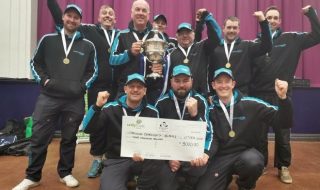All of the major fish farms the Environment Agency thought were potentially linked to this summer’s outbreaks of Koi Herpesvirus have now tested negative. This includes both vaccinated and unvaccinated carp.
“As we now have sufficient evidence that fish from these farms were not the cause of this summer’s outbreaks, all of these fish farms are now free to stock fish,” explained Environment Agency Fisheries Policy and Process Manager Adrian Taylor.
“The farms were tested for KHv antibodies and for viral genetic materials by the Centre for Environment, Fisheries and Aquaculture Science (Cefas).
“The vaccination process causes fish to produce KHv antibodies, and so the standard tests are not suitable for vaccinated fish. So we contracted Cefas to carry out alternative tests aimed at detecting any live virus. This involved a lengthy co-habitation of vaccinated fish with susceptible fish under stress at 23°C, in an attempt to trigger the virus if present.
“No virus was detected at the end of the co-habitation period. These results strengthen our view that there is no clear evidence that either vaccinated or unvaccinated fish from any of fish farms tested so far were the cause of any of the outbreaks.”
23 fisheries tested positive for KHv this year. Most of these had been stocked recently with carp. Although the fish farms tested negative, several fish suppliers had stocked carp to the affected waters, obtaining the fish from cropping waters that were overstocked with carp.
“We are now testing the cropping waters which might have been the sources of the KHv outbreak. In the meantime, these waters cannot be used as a source of stock fish,” continued
“The test results do not identify a clear source for the outbreaks. So how did the KHv outbreaks arise? Even if the cropping waters test positive for KHv this would still only explain some of the outbreaks.
“The results point to two key factors: the possible latency of the disease and the possibility that it is more widespread than originally thought. If KHv has been latent in many waters, it is likely high summer temperatures triggered the virus. We must now focus our efforts on establishing the distribution of the disease and the mechanisms that trigger it.”
The Department for the Environment, Food and Rural Affairs has recently announced its intention to make KHv a notifiable disease and are currently consulting stakeholders on the measures that need to be put in place. The results of the tests will be important in informing this discussion. In the meantime the Environment Agency is using its Section 30 powers to restrict further spread of the disease.
mtf
Koi Herpesvirus (2)
Latency
Scientific evidence suggests that KHv can be present in what is known as a latent form. This not only means that the fish display no symptoms, but it also makes detection of the virus very difficult. The tests carried out are the best available, but are not a guarantee that infectious KHv is not present in a latent form in the fish. Potentially KHv could be present in latent form in any carp, either vaccinated or unvaccinated. The tests show that the sites tested present a minimal and acceptable risk in terms of stocking, and certainly less risk than any untested source.
Testing protocol
All sampling of fish farms was supervised by Environment Agency or Cefas officers. This included the sampling of both vaccinated and unvaccinated carp from one fish farm.
The actions fishery owners and anglers should take to ensure angling continues to thrive include:-
· Encouraging fisheries to notify unusual mortalities on sites so these can be investigated for signs of disease (in the case of KHv there are unlikely to be any further mortalities at fisheries until late spring because expression of the disease is temperature dependent between 15C and 28C).
· Continuing to fish at your usual fishery sites and do not be dissuaded because of rumours it may or may not have experienced mortality problems due to KHv. In all cases where fisheries have reported mortalities to the authorities appropriate measures will have been taken to deal with the outbreak and advice given on ongoing biosecurity. From a fish disease perspective there is no reason why fishing should not continue at such sites once the outbreak is over and provided good biosecurity practises are implemented.
· Taking note that there is an extremely low risk of transfer of KHv between waters through angling. Most sites should be operating good biosecurity measures in the normal course of events, such as regular disinfection of angling equipment and this should be sufficient to prevent spread of KHv.
“The only reliable option for eradicating KHV from an infected fishery is to remove all stock, drain the fishery and disinfect with lime. However, this may not always be possible, especially in large waters,” added
“KHv is not yet a notifiable disease under European legislation. Therefore we cannot insist on the disinfection of a fishery that has KHv. The decision to cleanse/ empty lies with the fishery owner.
“As a precaution we are advising all fishery owners to put routine disinfection measures in place to protect against this and other fish diseases from infecting their waters.”
Further advice on disinfection techniques is available on the Environment Agency’s website www.environment-agency.gov.uk.


![banner_ea_logo[1].jpg](https://www.total-fishing.com/wp-content/uploads/2011/03/banner_ea_logo[1].jpg)



